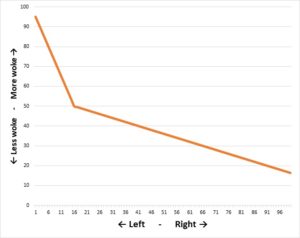The rise of “Cultural Socialism”? A review of two reports
SUGGESTED



Those reports make excellent complementary reading to the IEA’s own report “Left Turn Ahead? Surveying attitudes of young people towards capitalism and socialism”, since ours focused more on economics, and theirs more on socio-cultural issues.
The author, Prof Eric Kaufmann, broadly distinguishes between three different cultural tribes: “Cultural Leftists” (or “Cultural Socialists”), “Cultural Liberals”, and “Cultural Conservatives” (or “Cultural Patriots”).
Cultural Leftists are people who believe “that minorities must be protected from psychological harm arising from forms of dominant culture, and that a radical transformation of science, institutions, narratives and culture can redistribute power from dominant to subaltern groups.”
Cultural Liberals, on the other hand, “prioritise freedom of expression, equal treatment without regard to identity, the scientific method, freedom of conscience and the primacy of classical liberal traditions of law.”
And finally, Cultural Conservatives are people who “prioritise the defense of national, ethnic and religious traditions. The dominant form of cultural conservatism in Britain is cultural patriotism.”
Historically, liberals tended to form coalitions with conservatives on economic issues, and with leftists on cultural issues. I recently pointed out on our YouTube channel that this is no longer true today: the Great Awokening has made cultural coalitions between liberals and progressives almost impossible. In the 2020s, the biggest threats to social liberalism come from woke progressives, not nationalistic and/or religious conservatives. Prof Kaufmann comes to a similar conclusion:
“In the past the major conflict was between cultural conservatives on the one hand, and cultural liberals and socialists on the other. Today, however, the rising power of cultural leftism in elite institutions largely pits a rearguard of cultural liberals and patriots against cultural leftists.”
Indeed, in the subsequent pages, he groups liberals and conservatives together as the “anti-woke” (Prof Kaufmann prefers the more old-fashioned term “politically correct”) side of the divide.
Cultural attitudes are closely correlated with self-positioning on the political Left-Right spectrum: the further to the Left you place yourself, the more likely you are to approve of woke values, and of strict sanctions against those who violate them. But this is not a linear relationship: people who identify as “slightly Left” are not much woker than self-identified centrists. On some issues, they are not even that far away from right-wingers. “Wokery” is heavily concentrated among those who self-identify as “fairly left-wing” or “very left-wing”.
For example, 29% of those who identify as “slightly Left” believe that children should be taught that “Britain is a racist country”. This is a higher proportion than among centrists (20%) and right-wingers (6-8%), but the group that is furthest away from them are their more radical comrades to their Left, of whom 59% agree with that statement.
We get a similar pattern for the statement that it is “not okay to say ‘Anyone can make it in Britain’”. (Woke progressives consider this a “microaggression”, since it implies that Britain is broadly meritocratic, which, from a progressive perspective, constitutes a form of victim-blaming.) 28% of those who consider themselves slightly left-wing agree that it is indeed “not okay” to say that, which sets them apart from centrists (14%) and right-wingers (5-13%), but not as much as it sets them apart from those to the Left of them (52%).
The respondents are also presented with a case study, and asked what they make of it. In 2020, Edinburgh University renamed its David Hume Tower in response to a petition from students, who claimed that Hume “championed white supremacy.” Among centre-leftists, only one in five approve of this decision, compared to one in ten centrists, and one in twenty right-wingers. Half of respondents on the far-Left (or, depending on your perspective, the “real” Left), however, approve.
So, if we had to plot the degree of “wokeness” (say, on a scale from 0 – 100) against left-right orientation (say, 0 = Zarah Sultana, 100 = Nigel Farage), it would look roughly like this:

The further left you move, the woker you become – but, as mentioned, not linearly so. There is a gentle slope from the Right through the centre to the moderate Left, and then a sudden jump as you move further leftwards from there.
Thus, “Wokery” drives a wedge between the moderate Left and the far-Left, but it does no comparable thing on the other side. Prof Kaufmann believes that this is an advantage for the political Right. (Of this, I am not so sure. If this had been a group discussion rather than a survey which every participant answers on their own, I suspect the wokest Leftists would have set the tone, and their more moderate comrades – and probably quite a lot of centrists too – would have sheepishly trotted along.)
So much for the population as a whole. How about younger people?
Prof Kaufmann finds that among members of Generation Z, those who identify as left-wing outnumber those who identify as right-wing by a ratio of more than 3 to 1. If we filter out those who identify as only “slightly” left-wing or right-wing, the Left-to-Right ratio among this more committed group goes up to almost 5 to 1.
Prof Kaufman shows that this Left-Right ratio is broadly in line with earlier surveys, and it is by no means limited to the very young: as we move up the age scale, nothing much changes until we reach the late 30s. 37-year-olds are, in those surveys, indistinguishable from 18-year-olds (which echoes my own finding in Left Turn Ahead? that “40 is the new 20”).
Younger people have always been more left-wing than older people, but, as Prof Kaufmann makes clear, not to anything like the same extent as today. The gap has widened hugely over time.
But “Left” and “Right” are broad labels. What about specific issues? Respondents are presented with questions such as:
“Thinking about political correctness, are you generally in favour of it (it protects against discrimination), or against it (it stifles freedom of speech)?”
Among Zoomers, half come out in favour of political correctness, while only one in four are opposed, with the rest undecided. This is a remarkable result if we bear in mind that “political correctness” is a slightly pejorative term. Presumably, a more neutral term would have produced an even bigger pro-PC majority.
When presented with the curious case of author J.K. Rowling (a hate figure on social media for her alleged “transphobia”), one in three Zoomers, and one in five Millennials, say she should be dropped by her publishers. The glass-half-full view of this would be that these are not majorities. There are a lot of “Don’t know” respondents, but a relative majority of Millennials, and a very slim relative majority of Zoomers, do not want to cancel J.K. Rowling. The glass-half-empty view would be that the J.K. Rowling case is a particularly obvious case of a manufactured hysteria, where the outrage is out of all proportion to anything Rowling actually said.
Where do young people get these ideas from? A popular view among right-wing commentators is that this is all due to brainwashing by Marxist teachers and university lecturers, but Prof Kaufmann’s data does not really bear this out (although it does not exactly refute it either). Young people certainly are taught “Critical Social Justice” theories at school, either by teachers or guest speakers. Three out of four say that they have come across terms like “patriarchy”, “white privilege”, “unconscious bias” or “systemic racism” in class. Out of those, two thirds say that those ideas were presented as facts, not as contestable claims.
But at the same time, only one in ten respondents say that school is the place where they have encountered “woke” ideas for the first time, whereas half of them say that they first encountered them on social media. Prof Kaufmann’s takeaway:
“School is a socializing force, but its impact may lie less in introducing new ideas than in the way it reinforces, or fails to confront, ideological narratives in the wider youth culture.”
Meanwhile, university students are indeed “more woke” than those in employment, apprenticeships, or other activities. But this is also true for prospective university students, which would suggest that people already hold those views when they arrive at university.
People with right-wing and/or “unwoke” views are much more likely to say that they self-censor, because they fear either formal sanctions or at least negative social consequences for expressing their views. This is a clear indication of where cultural power currently resides in society: nobody is afraid of getting cancelled for being “too woke” or “too left-wing”. In principle, this effect exists across all age groups, but it is much more pronounced among younger people: they are the ones who feel the peer-pressure to go along with the prevailing orthodoxy most intensely.
What heightens that effect is exposure to woke terminology at school, and participation in diversity training courses in the workplace. The main effect of institutional wokery, then, is not to “brainwash” people, but to intimidate potential dissenters.
What I would like to see in future research would be an exploration of the overlap between what Prof Kaufmann calls “Cultural Socialism” and the more conventional economic socialism. I strongly suspect that the former is a subset of the latter: every cultural socialist is also an economic socialist, but not every economic socialist is also a cultural socialist.
If so, that would have an upside and a downside. The downside would be that liberals would be dealing with an influential opponent who is consistently wrong about everything across the board.
But at least, it would also mean that liberals would not have to fight on too many fronts at the same time. It is not that we are under attack from cultural socialists on one side, and from economic socialists on the other. If the economic socialists and the cultural socialists are largely the same people, it would mean that most of the bad ideas are concentrated in one place.




